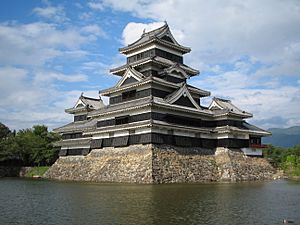Moat facts for kids
A moat is a deep, wide ditch, often filled with water, that was built around castles, towns, or other important buildings. Its main purpose was to protect the people inside and keep enemies out. Moats were first used a long, long time ago, starting around the 1100s. At first, they were just for safety. Later, some moats became very fancy, showing off how powerful and rich the castle owner was.

Moats were usually built near rivers or lakes so they could be easily filled with water. This water provided several important benefits. For example, if enemies tried to swim across, they would be easy targets for the castle's defenders. Also, the water made it impossible for attackers to dig tunnels under the castle walls, which was a common way to try and break in. Moats also helped protect the castle from fires.
What is a Moat?
The word moat comes from the French word motte. This word originally meant "hill." In the Medieval period, from about 1016 to 1164, many castles were built on top of high hills. The area at the bottom of these hills eventually became known as the moat.
How Moats Were Used
Castle moats could be quite deep, often between 5 and 40 feet. Interestingly, not all moats were filled with water. Some were simply very wide and deep ditches without water, and these were called dry moats. Even a dry ditch could be a big obstacle for attackers.
You might have heard stories where moats are filled with scary animals like alligators or crocodiles. This is just a myth and not true! However, moats were sometimes used to keep fish or eels for food, which was a practical use for the castle residents.
Images for kids
-
North view of the fortress of Buhen in Ancient Egypt.
-
The 17th-century fortified town of Naarden, Netherlands, showing bastions projecting into the wet moat
-
Moat surrounding Fort Pulaski National Monument near Savannah, Georgia
-
Bodiam Castle, a 14th-century castle near Robertsbridge in East Sussex, England
-
Caerlaverock Castle, a 13th-century castle in southern Scotland
-
The Forbidden City, Beijing: North-western angle
-
Egeskov Castle, Denmark
-
Sigiriya moat, Sri Lanka
-
Frozen moat of the walled city of Qufu, China
-
Fort Bourtange, a late 16th-century star fort in Groningen, Netherlands
-
Fort Brockhurst a mid-19th-century polygonal fort in Hampshire, England
-
Beijing ancient city gate and moat
-
Vellore Fort Moat, in Tamil Nadu, India
-
The Daalsesingel, a part of the moat that surrounds the city center of Utrecht, Netherlands
-
Forbidden City moat
See also
 In Spanish: Foso para niños
In Spanish: Foso para niños


























